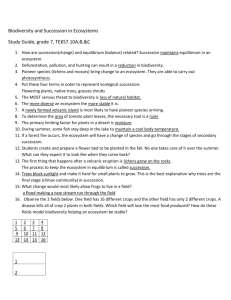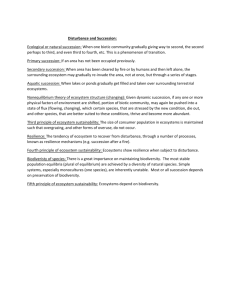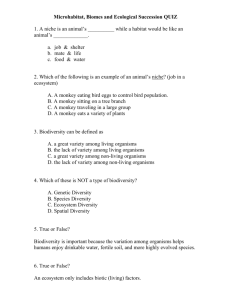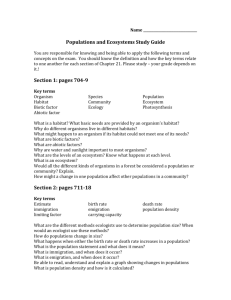352
advertisement
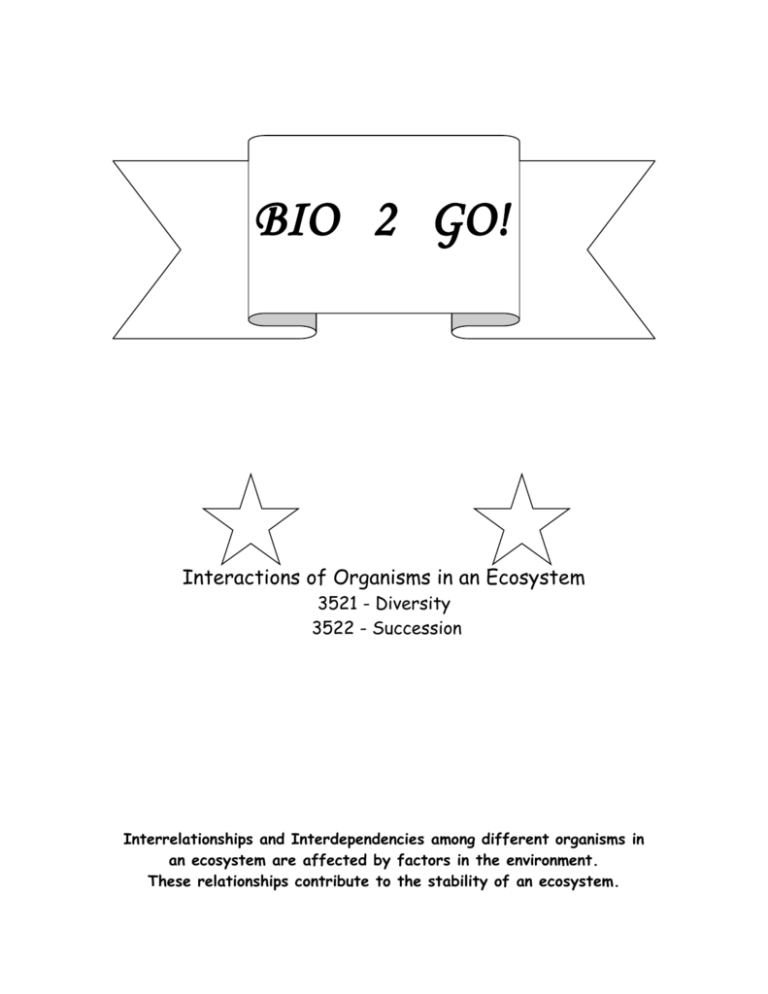
BIO 2 GO! Interactions of Organisms in an Ecosystem 3521 - Diversity 3522 - Succession Interrelationships and Interdependencies among different organisms in an ecosystem are affected by factors in the environment. These relationships contribute to the stability of an ecosystem. Objective: You should be able to 1. Explain the hierarchy of organisms interactions 2. Define biodiversity 3. Explain how diversity affects the ecosystem. 4. Explain and describe how succession happens. 5. Describe primary succession. 6. Describe secondary succession. 7. Use the following words in their correct context: Biodiversity Organism Population Community Ecosystem Biosphere Succession Primary succession Secondary succession Diversity 3521 Diversity is a good thing, in most cases. Biodiversity is the amount of different species of organisms that occupy an area. The measure of the amount of different types of organisms that can live in an area is a sign of the biological complexity in that area. It is generally thought that an area that contains a lot of different types of organisms is better off than an area that does not show the same amount of diversity. Interesting Scientific Fact: Biologists are monitoring the amphibian population in areas of concern. It is thought that the number of amphibians will show whether an area is healthy or unhealthy. The more amphibians they are able to locate, the better the area. REMEMBER THIS!!! Biodiversity is the number of different types of organisms that can live in an area. Biodiversity is usually a good thing. It is helpful in understanding Biodiversity to also understand the organization of organisms. Below is a helpful reminder of how organisms are grouped. Organism—Population— Community—Ecosystem—Biosphere The organism stage refers to the smallest units. Organism refers to the individual organisms. Population is a grouping of organisms. Finally, the biosphere includes all organisms, populations, communities and ecosystems in that area. Similar organisms make up a population. Several populations of different organisms make up a community. Several communities make up an ecosystem. And several ecosystems make up the biosphere. Biodiversity Diversity is the variety of living organisms in a community. You may have already heard the term biodiversity which is the measure of the numbers of organisms living in an ecosystem. An ecosystem is healthy and doing well if it has a lot of biodiversity. It means that there are a lot of different types of organisms living there and that there is plenty of food. That is good! Unhealthy ecosystems do not have a good biodiversity. An example of an ecosystem with good biodiversity would be a forest that has been untouched for hundreds of years. There are a lot of different organisms there and there are lots of them. A forest that just had a fire would not have good biodiversity because there are not many plants or animals there anymore. Interesting Scientific Fact: Airports do not like biodiversity. In fact, they prefer an ecosystem that does not have ay flying organisms. Why? Because flying organism, like birds, get in the way of the airplanes as they take-off and land. Sometime larger birds, like geese, actually fly into the airplane motors and create problems for the plane. Question 1: Define biodiversity in your own words. Student’s answers will vary Question 2: Does the North Pole have more biodiversity or less biodiversity then Maryland? Why do you think so? Less- the environment is colder and there are more organisms in Maryland. Succession 3522 Succession Ecosystems change over time. A shallow lake gradually fills in over time and becomes a meadow. A forest burns and becomes a field. A beaver dams a stream and creates a pond. These changes occur in a regular pattern and are called succession. Succession is the change in an ecosystem from simple to more complex. Remember a complex ecosystem is one that has great biodiversity. REMEMBER THIS!!! Succession is a process where the ever-changing environment favors one species over another. Certain species will replace another species because they are more suited to the new environment. After a forest fire, new sun-loving plants are often the first to begin the secondary succession. As they grow and create shade, shade-loving plants, such as maple trees, grow and create even more shade. The increased shade creates a lack of sunlight for the sun-loving plants. Because of the shade, the sun-loving plants fail to reproduce. The sun-loving plants are replaced in the ecosystem by the shade-loving plants that reproduce successfully in the shade. There are two types of succession: primary and secondary. 1. Primary succession is when plants grow where they have never grown before, such as on a new volcanic island. 2. Secondary succession is when plants grow in an area that had plants growing before, such as a field or forest that was cleared. A good definition of primary succession is when life begins to grow in an area that previously did not support life. It is also defined as the type of succession that occurs where no ecosystem existed before. Primary succession can occur on rocks, cliffs, and sand dunes. Usually the first species to begin primary succession is some type of algae or moss-both are very hardy and simple plants. You normally see them as a green film growing on the shady sides of trees and sometimes houses. Once these pioneers get established, they can change the area so that more complex organisms can live there. Secondary succession is more common than primary succession. Secondary succession occurs in ecosystems that have been disturbed or disrupted. A good example of secondary succession is when a fire destroys an area and the plants and animals begin to reestablish themselves in the area that was burned. Question 3: What is the major difference between primary and secondary succession? Primary succession occurs where nothing has been before, secondary is when organisms return to an area that was disturbed by a disaster. Question 4: Give an example of secondary succession around where you live. Student’s answers will vary. TEST YOURSELF True or False __T_ 1. Ecosystems are made up of a bunch of communities. __T_ 2. A community includes all the species within an area. __T_ 3. The number of species living within an ecosystem is a measure of its biodiversity. __F_ 4. The major difference between primary succession and secondary succession is that primary succession occurs only on land and secondary succession occurs in ponds and lakes. __F_ 5. A receding (melting and moving farther north) glacier is a good example of secondary succession. __F_ 6. A population is a grouping of different communities. __F_ 7. Ecosystems usually never change over time. __T_ 8. The biosphere contains all ecosystems in an area. Matching A. Measures the number of species living within an ecosystem. __C__ 1. Succession __E__ 2. Population __G__ 3. Community __A_ 4. Biodiversity __F__ 5. Primary Succession __B__ 6. Organism __H__ 7. Ecosystem __D__ 8. Secondary Succession B. One particular member (an individual)- is the smallest unit. C. Regular progression of species replacement in an environment. D. Example of when plants grow in an area that had plants growing before. E. A group of organisms living together in a particular place. F. When plants grow where there have never been plants before. G. A number of populations living in the same area. H. A number of communities living in the same area. Fill in the Blank secondary succession ecosystem population biodiversity primary succession 1. The number of species living within an ecosystem is a measure of its _BIODIVERSITY_____________. 2. Plants growing in an area where there were once plants before is called _SECONDARY SUCCESSION________. 3. A grouping of similar organisms is called _POPULATION__________. 4. An _ECOSYSTEM_______ is made up of several communities. 5. _PRIMARY SUCCESSION________ is when plants grow where there have never been any before. Answer the following: 1. How do you think succession is related to diversity? The longer succession continues the more diversity there will be in n ecosystem. 2. Which are would have a better biodiversity, a place where primary succession is happening or an area where secondary succession is happening? Give a reason why you think so. Student’s answers will vary 3. How does biodiversity affect an ecosystem? The more there is the healthier the ecosystem.

